计算物理 ›› 2021, Vol. 38 ›› Issue (6): 631-660.DOI: 10.19596/j.cnki.1001-246x.8379
• 综述 • 下一篇
许爱国1,2,3( ), 宋家辉4,1, 陈锋5, 谢侃4, 应阳君1
), 宋家辉4,1, 陈锋5, 谢侃4, 应阳君1
收稿日期:2021-04-15
出版日期:2021-11-25
发布日期:2022-04-27
作者简介:许爱国(1970-), 男, 研究员, 研究方向为物理力学、理论物理, E-mail: Xu_Aiguo@iapcm.ac.cn
基金资助:
Aiguo XU1,2,3( ), Jiahui SONG4,1, Feng CHEN5, Kan XIE4, Yangjun YING1
), Jiahui SONG4,1, Feng CHEN5, Kan XIE4, Yangjun YING1
Received:2021-04-15
Online:2021-11-25
Published:2022-04-27
摘要:
评述两个基于相空间的建模与分析方法及其应用。第一个是基于闵可夫斯基泛函的形态分析方法,第二个是基于离散玻尔兹曼方程的建模与分析方法。两者均是统计物理学相空间描述方法的进一步发展:以相对独立的行为特征量为基,构建相空间,使用该相空间和其子空间来描述系统的行为特征;该相空间中的一个点对应系统的一组行为特征;两点间的距离d可用来描述两组行为特征的差异,其倒数可用来描述两组行为特征的相似度(S=1/d);一段时间内两点间距离的平均值${\bar d}$可用来描述两个动理学过程的差异,其倒数可用来描述这两个动理学过程的相似度(Sp=1/${\bar d}$)。从历史角度,基于闵可夫斯基泛函的形态相空间分析方法在先,接受其启发是离散玻尔兹曼方法朝着相空间描述方法发展过程中的关键环节。形态分析方法独立于数据来源,因而离散玻尔兹曼模拟得到的结果,除了可以使用其自带的分析功能之外,还可进一步使用形态分析方法获得另一个层面或视角的认识。在复杂介质动理学研究中,这两个方法从不同的视角,使得许多以前无法提取的信息得以分层次、定量化研究。
中图分类号:
许爱国, 宋家辉, 陈锋, 谢侃, 应阳君. 基于相空间的复杂物理场建模与分析方法[J]. 计算物理, 2021, 38(6): 631-660.
Aiguo XU, Jiahui SONG, Feng CHEN, Kan XIE, Yangjun YING. Modeling and Analysis Methods for Complex Fields Based on Phase Space[J]. Chinese Journal of Computational Physics, 2021, 38(6): 631-660.

图3 (a) 形态相空间A-L-χ;(b) 形态区别度(或相似度);(c)过程区别度(或相似度)示意图
Fig.3 (a)Morphological phase space A-L-χ; (b)Morphological difference (or similarity); (c)Process difference (or similarity)

图4 冲击与卸载过程中的一组温度位型图(a) t=500 ns;(b) t=750 ns;(c) t=850 ns;(d) t=1100 ns
Fig.4 A set of configurations with temperature contour in the shock loading and unloading procedure (a) t=500 ns; (b) t=750 ns; (c) t=850 ns; (d) t=1100 ns
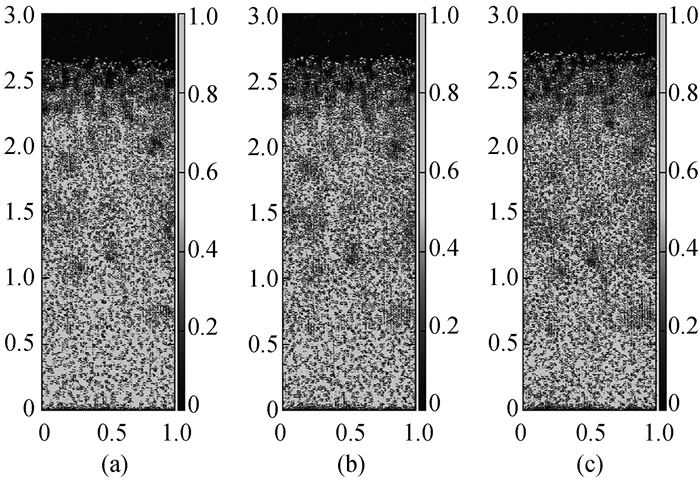
图9 三个相似动力学过程在500 ns时的温度斑图,冲击速度和温升阈值分别为(a) 1000 m ·s-1, 92 K; (b) 1100 m ·s-1, 120 K; (c) 1200 m ·s-1, 154 K
Fig.9 Condensed temperature patterns at 500 ns in three similar dynamical procedures (a) V=1000 m ·s-1, DT=92 K; (b) V=1100 m ·s-1, DT=120 K; (c) V=1200 m ·s-1, DT=154 K
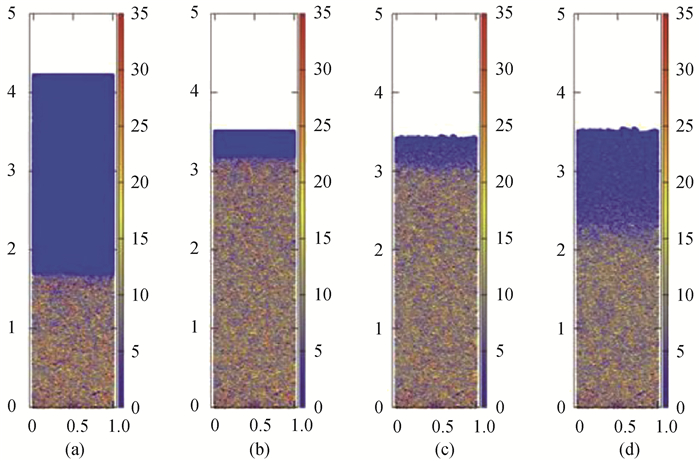
图12 冲击与卸载过程的一组压强位形图(孔隙度Δ=0.46,初始冲击速度V=1300 m ·s-1)
Fig.12 A set of configurations with pressure contours in shock loading and unloading procedure (Δ=0.46, V=1300 m ·s-1)
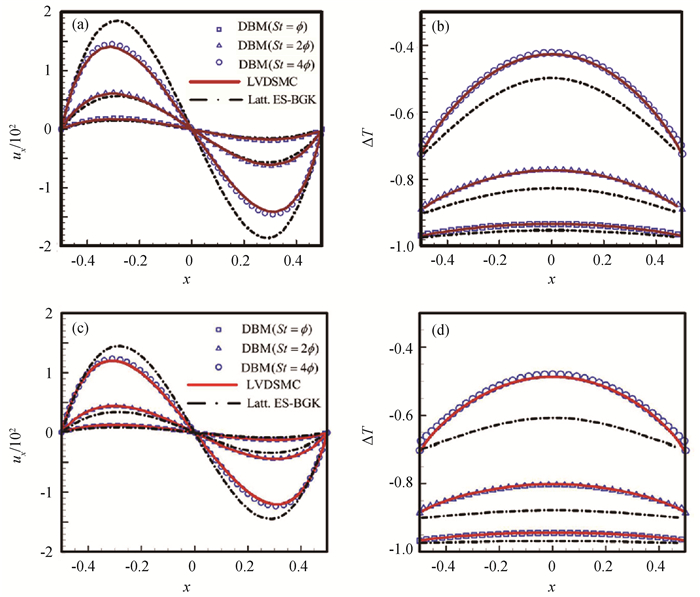
图21 Kn数为0.5时,(a) BGK气体的速度扰动;(b) BGK气体的温度扰动;(c) 硬球气体的速度扰动;(d) 硬球气体的温度扰动[55]
Fig.21 At Kn=0.5, (a) velocity perturbations for a BGK gas; (b) temperature perturbations for a BGK gas; (c) velocity perturbations for a hard-sphere gas; (d) temperature perturbations for a hard-sphere gas[55]
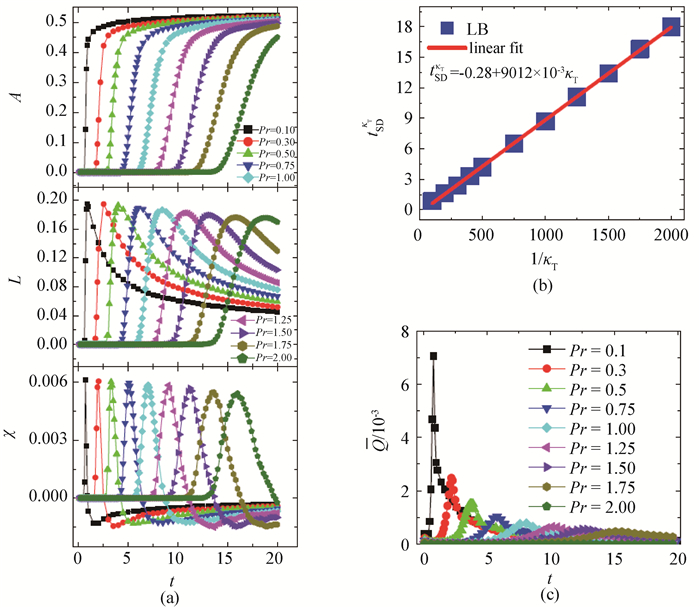
图24 闵可夫斯基形态学量、不同热传导系数下SD阶段持续时间及平均热通量随时间的演化
Fig.24 A schematic of Minkowski morphological quantity, SD stage duration at different heat transfer coefficients and average heat flux
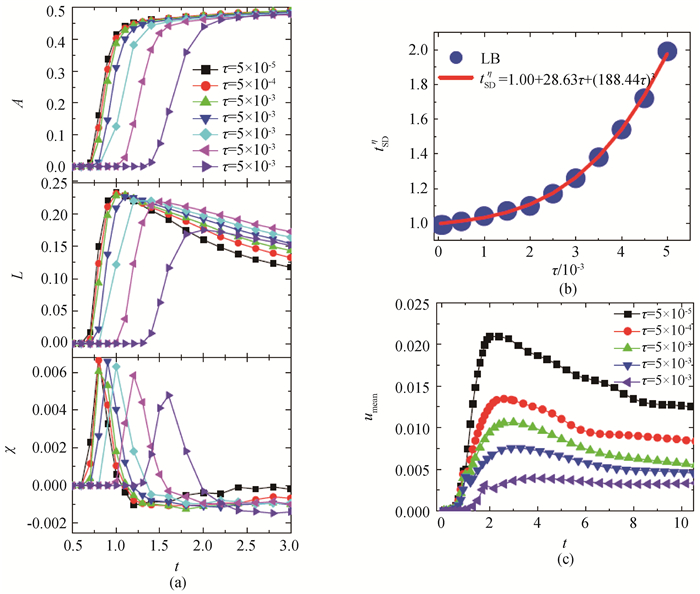
图25 闵可夫斯基形态学量、不同弛豫时间(黏性系数)下SD阶段持续时间及局域平均速度随时间的演化
Fig.25 A schematic of Minkowski morphological quantity, SD stage duration at different relaxation time (viscosity coefficient) and local average speed
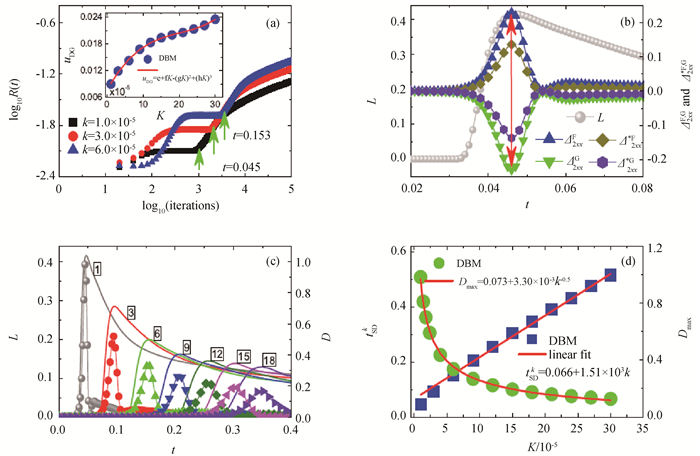
图26 (a) 图 21中相畴特征尺度R随时间的演化;(b) ρth=1.70时边界长度L和非平衡特征xx分量随时间的演化;(c)不同表面张力下边界长度L和相应热力学非平衡强度D随时间的演化; (d)亚稳相分解持续时间和最大非平衡强度随表面张力系数K的变化
Fig.26 (a) Evolutions of the characteristic domain sizes R; (b) Evolutions of the boundary length L and the xx component of some TNE manifestations; (c) Evolutions of the boundary lengths L (solid curves) and the corresponding TNE intensities D (curves with solid symbols) in phase separation processes with various K; (d) Duration of the spinodal decomposition stage tSD and the maximum TNE intensity Dmax as functions of K
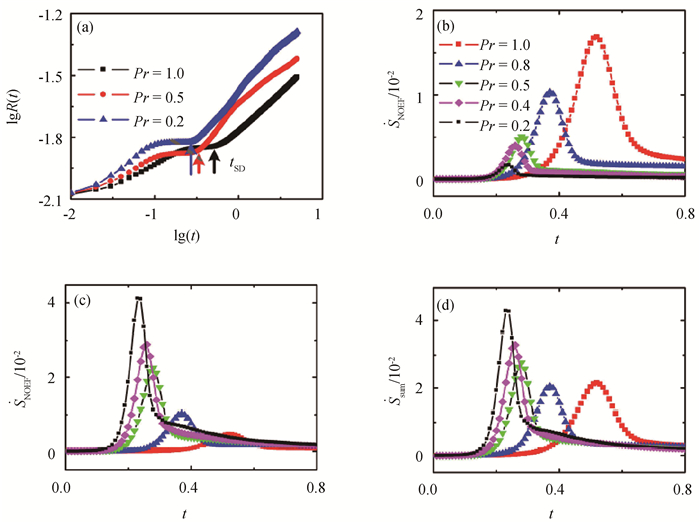
图28 不同热传导系数下相畴特征尺度和熵产生率演化
Fig.28 Profiles of characteristic domain sizes and rates of entropy production at different Prandtl numbers (heat conduction coefficient)

图33 临界时间和熵产生速率与表面张力的关系
Fig.33 Profiles of duration time of the SD stage (tSD) and amplitudes of entropy production rates as functions of coefficient of surface tension
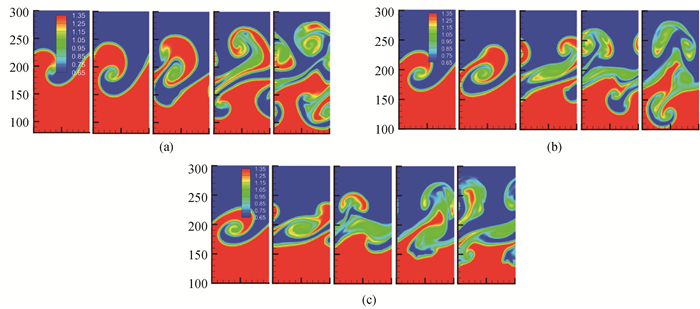
图35 耦合RTKHI系统的温度分布(a) g=0.005, u0=0.05; (b)g=0.005, u0=0.1; (c) g=0.005, u0=0.15 (图像从左到右分别对应t=100,150,200,250,300。)
Fig.35 Temperature distributions of coupled RTKHI (a) g=0.005, u0=0.05; (b)g=0.005, u0=0.1; (c) g=0.005, u0=0.15 (Images from left to right correspond to t=100, 150, 200, 250, 300, respectively.)
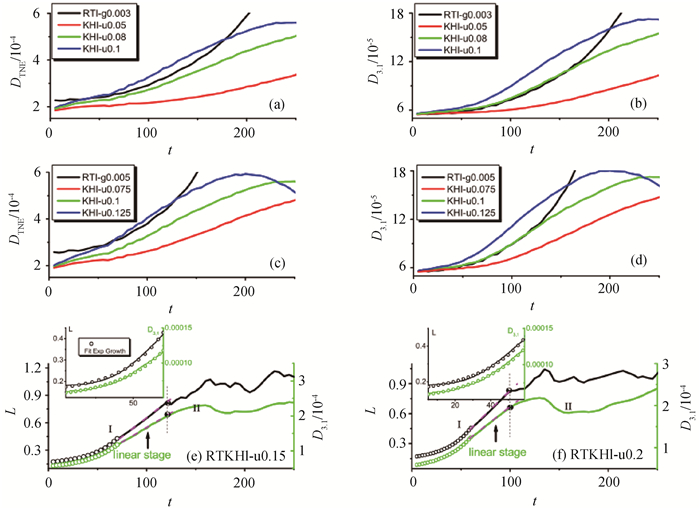
图38 非平衡特征在RTKHI系统早期主要机理判断(a)~(d)和过渡点捕获(e)~(f)中的应用
Fig.38 Applications of non-equilibrium characteristics in the early main mechanism judgment (a)- (d) and transition point capture(e)- (f)
| 1 | 陈式刚. 非平衡统计力学[M]. 北京: 科学出版社, 2010. |
| 2 | 沈惠川. 统计力学[M]. 合肥: 中国科学技术大学出版社, 2011. |
| 3 | SERRA J. Image analysis and mathematical morphology[M]. New York: Academic, Vols(1/2), 1982. |
| 4 |
MECKE K R. Morphological characterization of patterns in reaction-diffusion systems[J]. Phys Rev E, 1996, 53, 4794.
DOI |
| 5 |
AKSIMENTIEV A, MOORTHI K, HOLYST R. Scaling properties of the morphological measures at the early and intermediate stages of the spinodal decomposition in homopolymer blends[J]. J Chem Phys, 2000, 112, 1.
DOI |
| 6 |
MECKE K R, SOFONEA V. Morphology of spinodal decomposition[J]. Phys Rev E, 1997, 56, R3761- R3764.
DOI |
| 7 |
GÒŹDŹ W, HOŁYST R. High genus periodic gyroid surfaces of nonpositive Gaussian curvature[J]. Physical Review Letters, 1996, 76 (15): 2726.
DOI |
| 8 |
XU A, ZHANG G, YING Y, et al. Shock wave response of porous materials: From plasticity to elasticity[J]. Phys Scr, 2010, 81, 055805.
DOI |
| 9 |
XU A, ZHANG G, LI H, et al. Comparison study on characteristic regimes in shocked porous materials[J]. Chinese Phys Lett, 2010, 27 (2): 026201.
DOI |
| 10 |
XU A, ZHANG G, LI H, et al. Dynamical similarity in shock wave response of porous material: From the view of pressure[J]. Comput Math Appl, 2011, 61, 3618.
DOI |
| 11 |
XU A, ZHANG G, LI H, et al. Temperature pattern dynamics in shocked porous materials[J]. Sci China: Phys Mech Astron, 2010, 53 (8): 1466- 1474.
DOI |
| 12 |
GAN Y, XU A, ZHANG G, et al. Phase separation in thermal systems: A lattice Boltzmann study and morphological characterization[J]. Physical Review E, 2011, 84 (4): 046715.
DOI |
| 13 |
GAN Yanbiao, XU Aiguo, ZHANG Guangcai, et al. Lattice Boltzmann study of thermal phase separation: Effects of heat conduction, viscosity and Prandtl number[J]. Europhysics Letters, 2012, 97 (4): 44002.
DOI |
| 14 |
ZHANG Yudong, XU Aiguo, ZHANG Guangcai, et al. Entropy production in thermal phase separation: A kinetic-theory approach[J]. Soft Matter, 2019, 15 (10): 2245- 2259.
DOI |
| 15 |
CHEN Feng, XU Aiguo, ZHANG Yudong, et al. Morphological and non-equilibrium analysis of coupled Rayleigh-Taylor-Kelvin-Helmholtz instability[J]. Physics of Fluids, 2020, 32, 104111.
DOI |
| 16 | XU Aiguo, ZHANG Guangcai, YING Yangjun, et al. Complex fields in heterogeneous materials under shock: Modeling, simulation and analysis[J]. Science China: Physics, Mechanics & Astronomy, 2016, 59, 650501. |
| 17 |
XU Aiguo, ZHANG Guangcai, PAN X, et al. Morphological characterization of shocked porous material[J]. Journal of Physics D: Applied Physics, 2009, 42 (7): 075409.
DOI |
| 18 |
XU Aiguo, ZHANG Guangcai, ZHANG Ping, et al. Dynamics and thermodynamics of porous HMX-like material under shock[J]. Communications in Theoretical Physics, 2009, 52 (5): 901.
DOI |
| 19 |
许爱国, 张广财, 蔚喜军, 等. 冲击作用下多孔材料热力学特征的模拟与分析[J]. 中国工程科学, 2009, 11 (9): 13- 19.
DOI |
| 20 |
GAN Yanbiao, XU Aiguo, ZHANG Guangcai, et al. Discrete Boltzmann modeling of multiphase flows: Hydrodynamic and thermodynamic non-equilibrium effects[J]. Soft Matter, 2015, 11 (26): 5336- 5345.
DOI |
| 21 |
XU Aiguo, ZHANG Guangcai, GAN Yanbiao, et al. Lattice Boltzmann modeling and simulation of compressible flows[J]. Frontiers of Physics, 2012, 7 (5): 582- 600.
DOI |
| 22 |
CAGIN T, PETTITT B M. Grand molecular dynamics: A method for open systems[J]. Molecular Simulation, 1991, 6 (1-3): 5- 26.
DOI |
| 23 |
WU L, WHITE C, SCANLON T J, et al. Deterministic numerical solutions of the Boltzmann equation using the fast spectral method[J]. Journal of Computational Physics, 2013, 250, 27- 52.
DOI |
| 24 | BIRD G A. Recent advances and current challenges for DSMC[J]. Computers & Mathematics with Applications, 1998, 35 (1-2): 1- 14. |
| 25 |
GRAD H. On the kinetic theory of rarefied gases[J]. Communications on Pure and Applied Mathematics, 1949, 2 (4): 331- 407.
DOI |
| 26 | 刘畅, 徐昆. 离散时空直接建模思想及其在模拟多尺度输运中的应用[J]. 空气动力学学报, 2020, 38 (2): 197- 216. |
| 27 | SUCCI S. The lattice Boltzmann equation: For complex states of flowing matter[M]. Oxford University Press, 2018. |
| 28 | 郭照立, 郑楚光. 格子Boltzmann方法的原理及应用[M]. 北京: 科学出版社, 2009. |
| 29 | HE Y L, WANG Y, LI Q. Lattice Boltzmann method: Theory and applications[M]. Beijing: Science Press, 2009. |
| 30 | HUANG H, SUKOP M C, LU X. Multiphase lattice Boltzmann methods: Theory and application[M]. Wiley, 2015. |
| 31 |
LIANG H, HU X, HUANG X, et al. Direct numerical simulations of multi-mode immiscible Rayleigh-Taylor instability with high Reynolds numbers[J]. Physics of Fluids, 2019, 31 (11): 112104.
DOI |
| 32 |
SUN D. A discrete kinetic scheme to model anisotropic liquid-solid phase transitions[J]. Applied Mathematics Letters, 2020, 103, 106222.
DOI |
| 33 |
QIAN Y H, D'HUMIÈRES D, LALLEMAND P. Lattice BGK models for Navier-Stokes equation[J]. Europhysics Letters, 1992, 17 (6): 479.
DOI |
| 34 |
SHAN X, CHEN H. Lattice Boltzmann model for simulating flows with multiple phases and components[J]. Physical Review E, 1993, 47 (3): 1815.
DOI |
| 35 |
CHEN S, CHEN H, MARTNEZ D, et al. Lattice Boltzmann model for simulation of magnetohydrodynamics[J]. Physical Review Letters, 1991, 67 (27): 3776.
DOI |
| 36 | CHAI Z, SHI B. Multiple-relaxation-time lattice Boltzmann method for the Navier-Stokes and nonlinear convection-diffusion equations: Modeling, analysis, and elements[J]. Physical Review E, 2020, 102 (2): 023306. |
| 37 |
DU R, SUN D, SHI B, et al. Lattice Boltzmann model for time sub-diffusion equation in Caputo sense[J]. Applied Mathematics and Computation, 2019, 358, 80- 90.
DOI |
| 38 | XING H, DONG X, SUN D, et al. Anisotropic lattice Boltzmann-phase-field modeling of crystal growth with melt convection induced by solid-liquid density change[J]. Journal of Materials Science & Technology, 2020, 57, 26- 32. |
| 39 | ZHAN C, CHAI Z, SHI B. A lattice Boltzmann model for the coupled cross-diffusion-fluid system[J]. Applied Mathematics Letters, 2021, 400, 126105. |
| 40 | LI Xindong, ZHAO Yingkui, HU Zongmin, et al. Investigation of normal shock structure by using Navier-Stokes equations with the second viscosity[J]. Chinese Journal of Computational Physics, 2020, 37 (5): 505- 513. |
| 41 | LI Xiao, SUN Chen, SHEN Zhijun. Numerical simulation of one-dimensional elastic-perfectly plastic flow and suppression of wall heating phenomenon[J]. Chinese Journal of Computational Physics, 2020, 37 (5): 539- 550. |
| 42 | SUN Chen, LI Xiao, SHEN Zhijun. A Godunov method with staggered Lagrangian discretization applicable to isentropic flows[J]. Chinese Journal of Computational Physics, 2020, 37 (5): 529- 538. |
| 43 | ZHAO Fei, SHENG Zhiqiang, YUAN Guangwei. A positivity-preserving finite volume scheme based on second-order scheme[J]. Chinese Journal of Computational Physics, 2020, 37 (4): 379- 392. |
| 44 |
KARBALAEI A, KUMAR R, CHO H J. Thermocapillarity in microfluidics-A review[J]. Micromachines, 2016, 7 (1): 13.
DOI |
| 45 |
许爱国, 张广财, 应阳君. 燃烧系统的离散Boltzmann建模与模拟研究进展[J]. 物理学报, 2015, 64, 184701.
DOI |
| 46 | XU Aiguo, ZHANG Guangcai, ZHANG Yudong. Discrete Boltzmann modeling of compressible flows[M]//KYZAS G Z, MITROPOULOS A C, eds. Kinetic Theory, Chap 02. Rijeka: InTech, 2018. |
| 47 | 许爱国, 张广财, 甘延标. 相分离过程的离散Boltzmann方法研究进展[J]. 力学与实践, 2016, 38 (4): 361- 374. |
| 48 | 许爱国, 陈杰, 宋家辉, 等. 多相流系统的离散玻尔兹曼研究进展[J]. 空气动力学学报, 2021, 39 (3): 1- 32. |
| 49 |
XU Aiguo, LIN Chuangdong, ZHANG Guangcai, et al. Multiple-relaxation-time lattice Boltzmann kinetic model for combustion[J]. Physical Review E, 2015, 91 (4): 043306.
DOI |
| 50 |
MCNAMARA G R, ZANETTI G. Use of the Boltzmann equation to simulate lattice automata[J]. Phys Rev Lett, 1988, 61, 2332.
DOI |
| 51 |
MANELA A, HADJICONSTANTINOU N G. Gas-flow animation by unsteady heating in a microchannel[J]. Physics of Fluids, 2010, 22 (6): 062001.
DOI |
| 52 |
HOMOLLE T M M, HADJICONSTANTINOU N G. Low-variance deviational simulation Monte Carlo[J]. Physics of Fluids, 2007, 19 (4): 041701.
DOI |
| 53 |
HOMOLLE T M M, HADJICONSTANTINOU N G. A low-variance deviational simulation Monte Carlo for the Boltzmann equation[J]. Journal of Computational Physics, 2007, 226 (2): 2341- 2358.
DOI |
| 54 |
RADTKE G A, HADJICONSTANTINOU N G, WAGNER W. Low-noise Monte Carlo simulation of the variable hard sphere gas[J]. Physics of Fluids, 2011, 23 (3): 030606.
DOI |
| 55 |
ZHANG Y, XU A, ZHANG G, et al. Discrete Boltzmann method for non-equilibrium flows: Based on Shakhov model[J]. Computer Physics Communications, 2019, 238, 50- 65.
DOI |
| 56 |
SHANKAR P N, DESHPANDE M D. Fluid mechanics in the driven cavity[J]. Annual Review of Fluid Mechanics, 2000, 32 (1): 93- 136.
DOI |
| 57 | JOHN B, GU X J, EMERSON D R. Effects of incomplete surface accommodation on non-equilibrium heat transfer in cavity flow: A parallel DSMC study[J]. Computers & Fluids, 2011, 45 (1): 197- 201. |
| 58 |
HUANG J C, XU K, YU P. A unified gas-kinetic scheme for continuum and rarefied flows Ⅱ: Multi-dimensional cases[J]. Communications in Computational Physics, 2012, 12 (3): 662- 690.
DOI |
| 59 |
GAN Y, XU A, ZHANG G, et al. Discrete Boltzmann trans-scale modeling of high-speed compressible flows[J]. Physical Review E, 2018, 97 (5): 053312.
DOI |
| 60 |
YE X Y, LIN F W, HUANG X J, et al. Polymer fibers with hierarchically porous structure: Combination of high temperature electrospinning and thermally induced phase separation[J]. Rsc Advances, 2013, 3 (33): 13851- 13858.
DOI |
| 61 |
YEGANEH J K, GOHARPEY F, FOUDAZI R. Anomalous phase separation behavior in dynamically asymmetric LCST polymer blends[J]. RSC Advances, 2014, 4 (25): 12809- 12825.
DOI |
| 62 |
CORBERI F, GONNELLA G, LAMURA A. Spinodal decomposition of binary mixtures in uniform shear flow[J]. Physical Review Letters, 1998, 81 (18): 3852.
DOI |
| 63 |
XU A, GONNELLA G, LAMURA A. Phase-separating binary fluids under oscillatory shear[J]. Physical Review E, 2003, 67 (5): 056105.
DOI |
| 64 |
VERBERG R, POOLEY C M, YEOMANS J M, et al. Pattern formation in binary fluids confined between rough, chemically heterogeneous surfaces[J]. Physical Review Letters, 2004, 93 (18): 184501.
DOI |
| 65 |
POOLEY C M, YEOMANS J M. Stripe formation in differentially forced binary systems[J]. Physical Review Letters, 2004, 93 (11): 118001.
DOI |
| 66 |
MARENDUZZO D, ORLANDINI E, YEOMANS J M. Permeative flows in cholesteric liquid crystals[J]. Physical Review Letters, 2004, 92 (18): 188301.
DOI |
| 67 |
XU A, GONNELLA G, LAMURA A. Morphologies and flow patterns in quenching of lamellar systems with shear[J]. Physical Review E, 2006, 74 (1): 011505.
DOI |
| 68 |
GONNELLA G, LAMURA A, SOFONEA V. Lattice Boltzmann simulation of thermal nonideal fluids[J]. Physical Review E, 2007, 76 (3): 036703.
DOI |
| 69 | ZHANG Y D, XU A G, QIU J J, et al. Kinetic modeling of multiphase flow based on simplified Enskog equation[J]. Frontiers of Physics, 2020, 15 (6): 1- 13. |
| 70 |
CRISTINI V, TAN Y C. Theory and numerical simulation of droplet dynamics in complex flows-a review[J]. Lab on a Chip, 2004, 4 (4): 257- 264.
DOI |
| 71 |
TEZDUYAR T E. Interface-tracking and interface-capturing techniques for finite element computation of moving boundaries and interfaces[J]. Computer Methods in Applied Mechanics and Engineering, 2006, 195 (23-24): 2983- 3000.
DOI |
| 72 |
SZEWC K, POZORSKI J, MINIER J P. Simulations of single bubbles rising through viscous liquids using smoothed particle hydrodynamics[J]. International Journal of Multiphase Flow, 2013, 50, 98- 105.
DOI |
| 73 | 赵明娟, 邓志成, 赵龙志. 激光熔注中增强相颗粒对晶粒生长影响的CA模拟[J]. 功能材料, 2015, 46 (1): 6. |
| 74 |
DU L F, ZHANG R, ZHANG L M. Phase-field simulation of dendritic growth in a forced liquid metal flow coupling with boundary heat flux[J]. Science China Technological Sciences, 2013, 56 (10): 2586- 2593.
DOI |
| 75 |
JACQMIN D. Calculation of two-phase Navier-Stokes flows using phase-field modeling[J]. Journal of Computational Physics, 1999, 155 (1): 96- 127.
DOI |
| 76 |
XU A, GONNELLA G, LAMURA A. Numerical study of the ordering properties of lamellar phase[J]. Physica A: Statistical Mechanics and Its Applications, 2004, 344 (3-4): 750- 756.
DOI |
| 77 |
XU A, GONNELLA G, LAMURA A. Simulations of complex fluids by mixed lattice Boltzmann-finite difference methods[J]. Physica A: Statistical Mechanics and Its Applications, 2006, 362 (1): 42- 47.
DOI |
| 78 |
XU A, GONNELLA G, LAMURA A, et al. Scaling and hydrodynamic effects in lamellar ordering[J]. EPL (Europhysics Letters), 2005, 71 (4): 651- 651.
DOI |
| 79 |
ZHOU Y. Rayleigh-Taylor and Richtmyer-Meshkov instability induced flow, turbulence, and mixing Ⅰ[J]. Physics Reports, 2017, 720-722, 1- 136.
DOI |
| 80 |
ZHOU Y. Rayleigh-Taylor and Richtmyer-Meshkov instability induced flow, turbulence, and mixing Ⅱ[J]. Physics Reports, 2017, 723-725, 1- 160.
DOI |
| 81 | 廖深飞, 邹立勇, 黄熙龙, 等. Richtmyer-Meshkov不稳定的双椭圆气柱相互作用的PIV研究[J]. 中国科学: 物理学力学天文学, 2016, 46, 034702. |
| 82 |
DING J, SI T J, YANG J, et al. Shock tube experiments on converging Richtmyer-Meshkov instability[J]. Physical Review Letters, 2017, 119, 014501.
DOI |
| 83 |
HUANG S, XU J, LUO Y, et al. Smoothed particle hydrodynamics simulation of converging Richtmyer-Meshkov instability[J]. Physics of Fluids, 2020, 32, 086102.
DOI |
| 84 |
WANG Z, XUE K, HAN P. Bell-Plesset effects on Rayleigh-Taylor instability at cylindrically divergent interfaces between viscous fluids[J]. Physics of Fluids, 2021, 33 (3): 034118.
DOI |
| 85 |
LAI H, XU A, ZHANG G, et al. Nonequilibrium thermohydrodynamic effects on the Rayleigh-Taylor instability in compressible flows[J]. Physical Review E, 2016, 94 (2): 023106.
DOI |
| 86 | CHEN F, XU A G, ZHANG G C. Viscosity, heat conductivity, and Prandtl number effects in the Rayleigh-Taylor instability[J]. Frontiers of Physics, 2016, 11 (6): 1- 14. |
| 87 |
LIN C, XU A, ZHANG G, et al. Discrete Boltzmann modeling of Rayleigh-Taylor instability in two-component compressible flows[J]. Physical Review E, 2017, 96 (5): 053305.
DOI |
| 88 |
YE H, LAI H, LI D, et al. Knudsen number effects on two-dimensional Rayleigh-Taylor instability in compressible fluid: Based on a discrete Boltzmann method[J]. Entropy, 2020, 22 (5): 500.
DOI |
| 89 |
CHEN F, XU A, ZHANG G. Collaboration and competition between Richtmyer-Meshkov instability and Rayleigh-Taylor instability[J]. Physics of Fluids, 2018, 30 (10): 102105.
DOI |
| [1] | 花巍, 吕嫣, 刘世兴, 刘学深. 立方五次方非线性薛定谔方程的动力学及模式漂移[J]. 计算物理, 2017, 34(4): 495-504. |
| [2] | 张菁, 樊养余, 李慧敏, 孙恒义, 贾蒙. 相空间重构中延迟时间选取的新算法[J]. 计算物理, 2011, 28(3): 469-474. |
| [3] | 吕小青, 曹彪, 曾敏, 黄石生, 刘晓光. 确定延迟时间互信息法的一种算法[J]. 计算物理, 2006, 23(2): 184-188. |
| [4] | 马军, 吴宁杰, 应和平, 蒲忠胜. 局部相空间压缩实现对时空混沌和螺旋波的控制[J]. 计算物理, 2006, 23(2): 243-248. |
| [5] | 游荣义, 陈忠. 相空间中脑电近似熵和信息熵的计算[J]. 计算物理, 2004, 21(4): 341-344. |
| 阅读次数 | ||||||
|
全文 |
|
|||||
|
摘要 |
|
|||||
版权所有 © 《计算物理》编辑部
地址:北京市海淀区丰豪东路2号 邮编:100094 E-mail:jswl@iapcm.ac.cn
本系统由北京玛格泰克科技发展有限公司设计开发
